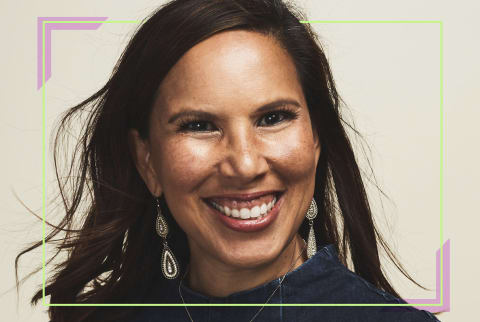Advertisement
My Dystonia Made Walking Unbearable — 10 Years Later I Ran A Marathon


When I turned 11 years old—right at the onset of puberty, no less—I felt my ankle inverting uncontrollably. What should have been a painful but otherwise unremarkable injury for a kid my age was actually the start of a lifelong health journey.
The ankle caused one of my feet to drag, and for the next two years, I was in and out of hospitals trying to find an answer. Finally, around age 13, I was given a diagnosis of dystonia, which is a rare movement control disease that affects around 300,000 people. Symptoms include a foot cramp or a tendency for one foot to turn or drag, writer's cramp, tremors, and involuntary pulls of the neck. It's often considered a "hidden" disability or an "invisible" illness because it's so rare and, therefore, difficult to diagnose—but as my dystonia progressed, it made itself very known.
Around the time of my diagnosis, it became difficult for me to write with my dominant right hand, so I taught myself to write with my left. At this point, it was nearly impossible to hide my condition. Not being able to participate in certain physical events with kids my age made me feel isolated at times, but I was blessed to have loyal and loving friends growing up, and I began dedicating that time to my academics. I have always been a glass-half-full person, so I quickly accepted my body and my brain as the package I was given, and instead of lamenting, I found ways to remove the obstacles they presented.
How I learned to live with my dystonia.
The year before I got sick, I had moved from Trinidad to the United States. As a mixed-race immigrant with an accent, I was used to being different from my peers, which helped me adapt to also being differently abled.
While in college, my dystonia progressed and traveled to my other leg: My toes curled into claws, so I had to move incredibly slowly, but I kept moving. In fact, in my mid-20s, I ended up moving to New York to work on Wall Street—ironically one of the most fast-paced jobs in one of the most fast-paced cities. Though I was "successful" in the financial sense of the word, I became consumed with the work and neglected my general health and nutrition. The lifestyle of working outrageous hours (paired with my stubborn attitude) exacerbated the disease.
Thankfully, though, I found a good neurologist who provided me with genetic counseling. After finding out that my disease is genetic (I have the DYT1 form of dystonia, meaning my DYT1 gene is mutated), I made the decision that I was likely not going to have children. Instead, I focused my attention on getting my Master of Business Administration (MBA) from Stanford, which, due to my dystonia, my friends and family strongly urged against. Everyone was coming from a place of love and concern, but I'm a stubborn person by nature. Please don't let the disease take me off the journey I know I am supposed to be on became my battle cry.
Like all the challenges in my past, I faced the master's program head-on, and I found a group of friends at Stanford that supported every part of me. I'll never forget them fighting over who got to ride in my car for the "VIP" treatment (aka front-row parking spots). They took my handicap placard, which was previously a source of self-consciousness for me, and made it cool.
After graduating with an MBA in 2004, I got a job working for American Express. After everything I'd accomplished up to that point, it should have been smooth sailing, but my dystonia was progressively getting worse.
Eventually my dystonia progressed, and I had to decide on a treatment.
I was in a tremendous amount of pain so often, I had to start taking breaks at work. One winter evening, the snow was coming down and I couldn't get a cab. At that moment, I realized I might have to stop going out, as walking was becoming unbearable, borderline impossible. My disease was beginning to be debilitating.
For the past year and a half, my neurologist had been asking me to take medication, but because of the risk of extreme fatigue, I refused. After investing so much money and time into my program at Stanford, I wasn't about to just sit in meetings and doze off. No chance!
Another option presented to me was deep brain stimulation (DBS), a brain surgery that uses an implanted medical device to treat dystonia. I was hesitant, but I ran through the scenarios: worst case, the surgery goes poorly and I end up in a wheelchair, or I do nothing and I still end up in a wheelchair. So, I called the doctor and told him I was ready.
Two weeks later, with my head shaved, I entered into an eight-hour surgery, performed while I was awake. It was on that operating table where I had the life-defining thought: If I get out of surgery and walk without pain, I would also learn to run.
How I went from barely walking to running a marathon.
Six weeks post-op, I did walk—and with ease! I spent that whole summer walking around New York, grinning from ear to ear (I swear people thought I was losing it).
Not long after that, I quit my job and began working at Equinox. With access to the gym, I started training for my first 10K, followed by several half-marathons. In my Stanford entry essay so many years before, I shared that my ultimate dream would be to one day run a marathon—and in 2018, I finally did.
When the New York City Marathon led me past Mount Sinai, where just 10 years earlier, my mom wheeled me out of the hospital doors with a bald head and bandages, I fell to my knees and cried. That surgery changed my life, and the power of that moment was not lost on me.
Of course, this journey hasn't been perfect: I've had multiple malfunctioning batteries and disconnected wires in my neurostimulator, and sometimes I have to go back to using a cane. In the midst of all of the challenges, I think back to when I wasn't able to use my right hand, when I wasn't able to use my two feet, and revel in the fact that I'm now running marathons and a business.
Today, I work passionately as a CEO at a health care company. I know now that neglecting my health is not an option: I go to bed at 10 p.m. every night and sleep for eight hours, I try to exercise five days a week, and I take time off of work when I need to.
What I want people to know about dystonia.
Living with dystonia is not always easy. Because my surgery has enabled me to live a "normal" life, my already rare condition has become even more "invisible." Though the science was life-altering and has made for a lot of good days, there are still some bad days. I know my body best; I know how to care for it now (I get quality sleep, I eat little meat, and I try to avoid processed foods and alcohol). I wake up every day knowing I am one of the lucky ones that the DBS surgery has helped, and still, I know when something within my body feels wrong.
Without the right care, an invisible illness can be incredibly frustrating and isolating: I've had doctors tell me I'm "fabricating stories for attention," later to find out (with the right care) that I was having issues with my stimulators. If you're living with dystonia or another invisible illness—diagnosed or yet to be—always be an advocate for yourself, always!, because you know your body best.
Lastly, dystonia is not a death sentence: It makes living life a little trickier, but with loving friends and family, you will always be reminded of who you are, not what the disease has done to you.
When people try to talk me out of chasing after my dreams—whether it's making a big move, running a marathon, or becoming a CEO—I thank them for their feedback, then let them know I'm giving it a shot anyway. My differences do not limit me, even in the face of my biggest challenges.
Watch Next
Enjoy some of our favorite clips from classes
Enjoy some of our favorite clips from classes
What Is Meditation?
Mindfulness/Spirituality | Light Watkins
Box Breathing
Mindfulness/Spirituality | Gwen Dittmar
What Breathwork Can Address
Mindfulness/Spirituality | Gwen Dittmar
The 8 Limbs of Yoga - What is Asana?
Yoga | Caley Alyssa
Two Standing Postures to Open Up Tight Hips
Yoga | Caley Alyssa
How Plants Can Optimize Athletic Performance
Nutrition | Rich Roll
What to Eat Before a Workout
Nutrition | Rich Roll
How Ayurveda Helps Us Navigate Modern Life
Nutrition | Sahara Rose
Messages About Love & Relationships
Love & Relationships | Esther Perel
Love Languages
Love & Relationships | Esther Perel
What Is Meditation?
Box Breathing
What Breathwork Can Address
The 8 Limbs of Yoga - What is Asana?
Two Standing Postures to Open Up Tight Hips
How Plants Can Optimize Athletic Performance
What to Eat Before a Workout
How Ayurveda Helps Us Navigate Modern Life
Messages About Love & Relationships
Love Languages
Advertisement

This Little-Known Supplement Helps Women Sleep & Decreases Signs Of Depression
Molly Knudsen, M.S., RDN

This Little-Known Supplement Helps Women Sleep & Decreases Signs Of Depression
Molly Knudsen, M.S., RDN















